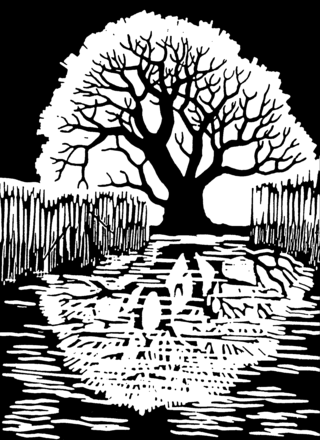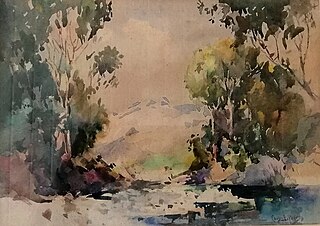
Linocut, also known as lino print, lino printing or linoleum art, is a printmaking technique, a variant of woodcut in which a sheet of linoleum is used for a relief surface. A design is cut into the linoleum surface with a sharp knife, V-shaped chisel or gouge, with the raised (uncarved) areas representing a reversal of the parts to show printed. The linoleum sheet is inked with a roller, and then impressed onto paper or fabric. The actual printing can be done by hand or with a printing press.
Albín Brunovský was a Slovak painter, graphic artist, lithographer, illustrator and pedagogue, considered one of the greatest Slovak painters of the 20th century.

Jacques Hnizdovsky, (1915–1985) was a Ukrainian-American painter, printmaker, graphic designer, illustrator and sculptor.

Adolph Stephan Friedrich Jentsch was a German-born Namibian artist. He studied at the Dresden Staatsakademie für Bildende Künste for six years, and used a travel grant award to visit France, Italy, UK and the Netherlands. Jentsch moved to Namibia in 1938 to escape the approaching war and lived there until his death. He travelled extensively in Namibia and eventually settled down near Dordabis, about 60 km from the capital Windhoek. He is one of Namibia's most famous painters.

The Diocese of Namibia is part of the Anglican Church of Southern Africa, which is itself part of the Anglican Communion. The diocese, which covers the whole country of Namibia, was originally known as the Diocese of Damaraland. Most of the Anglicans in Namibia live in Ovamboland in the north of the country and speak the Oshikwanyama language.
Mandume ya Ndemufayo was the last king of the Oukwanyama, a subset of the Ovambo people of southern Angola and northern Namibia. Ya Ndemufayo took over the kingdom in 1911 and his reign lasted until 1917 when he died of either suicide or machine gun fire while he was under attack from South African forces. Ya Ndemufayo is honoured as a national hero in both Angola and Namibia.
Peter Clarke was a South African visual artist working across a broad spectrum of media. He was also a writer and poet.
Rorke's Drift Art and Craft Centre is a center for arts and crafts, including fine art, printmaking, pottery and weaving, located in KwaZulu-Natal, South Africa. It has been described as "the most famous indigenous art centre in South Africa".

Hans Anton Aschenborn was a renowned animal painter of African wildlife. He is the father of Dieter Aschenborn and the grandfather of Hans Ulrich Aschenborn, both painters.
Philippa Hobbs is a published South African art historian, an artist and an art collector. She was born in 1955 and matriculated at St Andrew's School in 1972. She studied art at the Johannesburg College of Art before finishing a post-graduate printmaking course at the University of the Arts (Philadelphia). She then furthered her studies through University of South Africa (UNISA) and the Technikon Witwatersrand. Hobbs was a senior professor of history of art at the University of the Witwatersrand in Johannesburg from 1988 to 1993. She has been noted for her contribution to the practice of art, art education, research and, most recently, community development through art. Hobbs currently works as MTN art collection curator and arts and culture portfolio senior manager.
Leonard Beaumont (1891–1986) was an English printmaker, graphic designer, illustrator and publisher. He was one of the earliest exponents of the new art of linocut printmaking in Britain during the early 1930s. He was one of a small group of progressive and highly regarded printmakers who exhibited at the Redfern and Ward Galleries in central London. Whilst working in relative isolation in Yorkshire, most of his contemporaries were linked in some way to the Grosvenor School of Modern Art, located in Pimlico, London.
Odibo is a village in the north of Namibia close to the Angolan border known for its Anglican mission St Mary. It belongs to the Oshikango electoral constituency in the Ohangwena Region. Odibo is also an Archdeaconry in the Diocese of Namibia.
Palle Louis Nielsen was a Danish illustrator and graphic artist. Considered to be one of the masters of his times, his works include drawings, watercolours, woodcuts and linocuts.

Charles Ernest Peers was a South African artist.
Ian Gardiner (1943–2008) was a Melbourne-based artist whose practice ranged from screen printing, linocuts and photographs through to woodblock prints, monoprint, collage and montage. Gardiner also returned to painting late in his career.
Miloš Ćirić was a Serbian visual artist and educator. The fields of his interest were art graphics, graphic identification, lettering, advertisement, book design, graphic animation, graphic-in-space and heraldry.
James Lesesne Wells was an African American graphic artist, print-maker, and painter associated with the Harlem Renaissance. He was an influential art professor at Howard University from 1929 to 1968 and is considered a pioneer in modern art education.
Bongiwe or Bongi Dhlomo-Mautloa, is a Zulu South African printmaker, arts administrator and activist.

Allan Holder Jordan (1898-1982) was an Australian painter, designer, printmaker and teacher.






